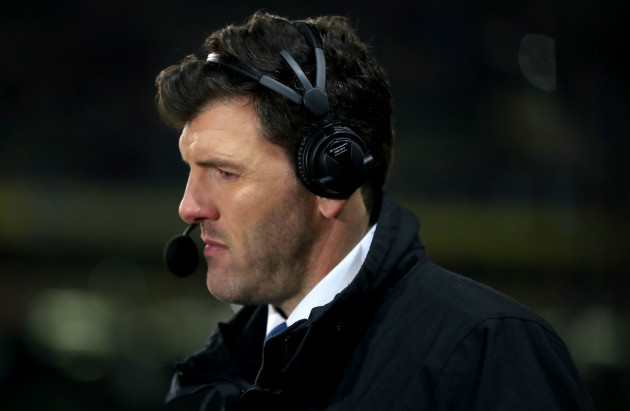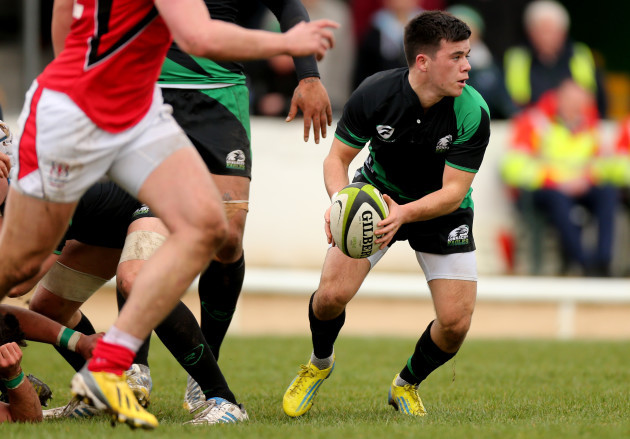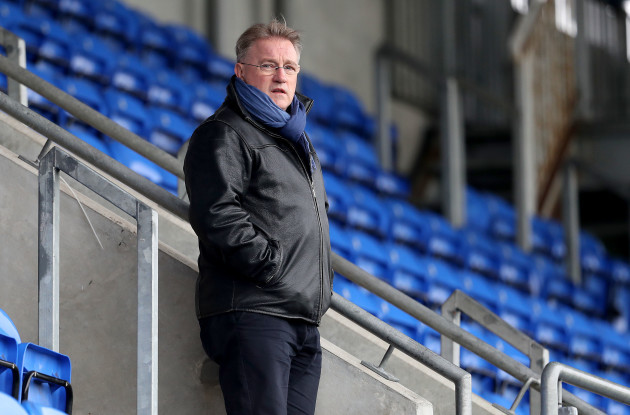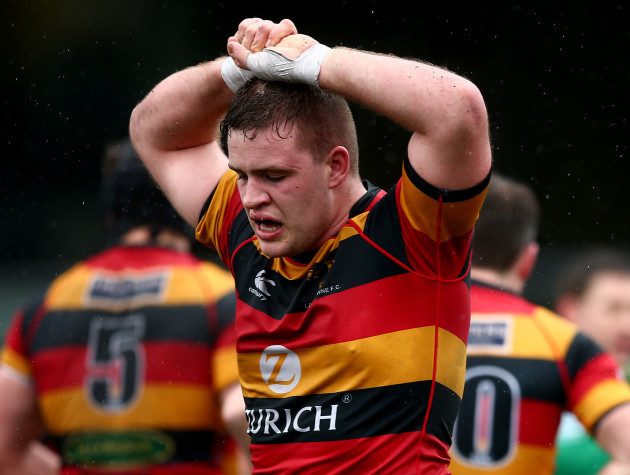NEW YORK IS famous for many things but it’s fair to say that the rugby community isn’t among its best-known features.
Those within New York’s rugby family believe it is a sleeping giant, however, and there are plans now in place to bring it to a far greater stage, with the announcement this month of the city’s first-ever professional club, Rugby United New York [RUNY].
The club is part of the newly-formed Major League Rugby [MLR], the latest attempt to get a professional rugby competition off the ground Stateside – and one that will kick off its inaugural season in April with justified optimism that it can survive and thrive.
RUNY won’t take part in the 2018 season, instead playing a series of ‘exhibition’ games this year, but they will compete in the 2019 campaign, by which time the club expects to have solid, sustainable foundations in place.
The Irish connections in RUNY are multiple, starting with club chairman and founder James Kennedy, a St. Munchin’s College, Limerick alumnus who has lived in New York for almost 20 years and is the CEO of construction company Murphy Kennedy Group.
Former Ireland head coach Eddie O’Sullivan and ex-Ireland wing Shane Horgan are onboard as advisors, while Irishmen Marcus Walsh, Jack Fitzpatrick, Ross Deacon, Dylan Fawsitt [now a US international] and Dave Gannon are part of RUNY’s squad.
The club has closely linked itself with the GAA in New York and will play its first-ever game against Boston at Gaelic Park in the Bronx on 24 March, with the hope being that Gaelic Park will become RUNY’s home venue for the next few years.
With the RUNY centrally focused on building from the very grassroots of New York rugby up, these are exciting times in the Big Apple.
Kennedy has been deeply involved in New York’s rugby scene for a long time and is a board member of the local branch of USA’s Play Rugby, an initiative that provides disadvantaged children with an opportunity to try the sport.
“Every single week in New York City, 5,500 kids from really bad neighbourhoods, usually African-American kids, are playing rugby,” says Kennedy.
“Of all the kids over the 11-year programme, there’s a 99% graduation rate into high schools from neighbourhoods where the normal graduation rate is 37%. A lot of them are now going to college too.”
Kennedy sees these figures as proof of the thirst for rugby in the Big Apple and also the good it can do in people’s lives. Indeed, he cites the values of rugby as a core reason why he believes America will come to love the sport on a truly national scale.
Realistically, the numbers are the most important thing if RUNY and the MLR are to be successes. Kennedy says the demographic is there in New York.
With 54 men’s rugby clubs, 169 rugby-playing high schools and more than 60 rugby-playing colleges in the Tri-State Area, there is an ever-growing playing base to draw from and Kennedy cites a population of 32.5million people as the club’s “catchment area”.
He was contacted by the Pro14 when they began considering an expansion into the US and while his research returned these encouraging numbers, Kennedy did not believe that putting a New York club into the Pro14 was the right move.
“I met with New York Cosmos and New York FC, two soccer clubs,” explains Kennedy. “Cosmos is a failed soccer expansion and New York FC is a fantastically successful one.
“Cosmos said they did everything wrong, wasted so much money, lost $80m in two years. NYFC spent a lot of money too but they came in at a youth level five years before their club was announced and built their brand at the grassroots level.
“Cosmos came in and signed Raul and built a big stadium and sold out one game, and that was it.
“I said to [Pro14 CEO] Martin Anayi, ‘if you announce a New York team now and give me five years to build it, it will work fantastically. If you announce a New York team and it’s supposed to play in September, it won’t work. The team won’t be good enough, the community won’t engage. USA Rugby wouldn’t support them either.’
“It had to be organic, it had to be involved in the community, there had to be US-qualified players in the team. We’re now stacked with US-qualified players. So it is everything the Pro14 wasn’t willing to do at that time.”
That desire not to rush into things is the reason RUNY won’t compete in MLR in 2018, as they look to build sustainable foundations first – finalising stadium plans, training facilities, their links to schools, local clubs and college programmes.
That said, there is already a squad of players in place under Mike Tolkin – head coach of the US Eagles from 2012 to 2015 – with training having begun last weekend.
There are several notable Irishmen in the group, namely former Connacht academy scrum-half Marcus Walsh, ex-Ireland Schools fullback Jack Fitzpatrick, Ireland U20-capped back row Ross Deacon and former Blackrock College hooker Dylan Fawsitt – who made his debut for the US last weekend against Chile, having qualified on residency grounds.
Dave Gannon, the ex-Connacht, Leinster and Exeter lock/back row who captained the Ireland U21s to a World Cup final in 2004, has also signed on, having recently moved to New York.
Now 35-year-old Gannon finished his second spell with Connacht in 2013 and contacted his cousin, AJ MacGinty, who was studying, coaching and playing rugby at Life University in Atlanta at the time.
Having listened to MacGinty’s rave reviews of the set-up, Gannon moved to ‘Life U’ in early 2014, working towards a sports health science degree, as well as coaching for the first time.
Having played against Old Blue RFC, one of New York’s most famous clubs, during his years at Life U, Gannon had come into contact to their head coach Marty Veale and when he finished studying last year, was convinced to move to the Big Apple and join Old Blue.
“The community here is great,” says Gannon. “For the Six Nations games, a lot of the Old Blue lads go down to a bar called the Long Hall. We’re in there at 9 in the morning getting our full Irish and Tayto crisps, a good crowd watching the Six Nations.
“It’s on NBC over here now, with Alex Corbisiero presenting and he’s saying they’re getting a lot of viewers watching it. The more rugby on TV in America, the better!”
That rapid growth of the sport is what everyone involved in US rugby is talking about now and Gannon is thrilled to be part of something that could hugely boost the US Eagles in the international game.
“Who doesn’t want to see a strong US national team? Everyone in the rugby world does,” says Gannon. “There’s massive potential in America and people will be interested to see if they can eventually compete with Tier 1 nations.”
Kennedy is also pleased to be able to call on the expertise of O’Sullivan and Horgan as RUNY gets up and running.
O’Sullivan has had two stints as head coach of the Eagles, while Horgan can offer insight into the recruitment of coaches and players, as well as the workings of the media.
“I met Shaggy at some dinners over the years and he always seemed a very intelligent man,” says Kennedy. “It became regular calls where I’d talk to Shane.
“He put me in touch with Eddie and we met in Dublin a few months ago and talked for three hours. You don’t know someone’s rugby IQ until you meet them and Eddie’s is off the charts.
“I told Eddie I couldn’t afford him right now, but I wanted him involved. He’s coming out in a few weeks to do some coaching clinics for us. He knows the American rugby psyche very well. How he fits in long-term I don’t know, but I hope he does.”
While there is a clear Irish influence at RUNY, the focus is on players who can play for the US.
“It’s not an official league mandate, but a personal one – we want to help make the US national team as good as possible because that will help us,” says Kennedy.
“The US team gets better, more people come to our games, the more money we make, the better we can take care of our players – it’s that loop.”
RUNY have been invited to play several European clubs this summer during their exhibition season but already there is major excitement to get stuck into MLR in 2019.
As an associate member of MLR, RUNY are already contributing to what is a single entity league, operating in the same manner as Major League Soccer.
There are seven other members - Austin Elite, Glendale Raptors, Houston Sabrecats, New Orleans Gold, San Diego Legion, Seattle Seawolves, Utah Warriors – and each club has capital commitments of around $570,000 a year.
“We pay that a year in advance so there’s always a cash reserve there, which is key,” says Kennedy. “That wasn’t the case with PRO Rugby and that cash reserve covers the players’ wages, so we can say with certainty that their wages are covered, because there was an issue with the last league paying players.”
The fact that sports network CBS has signed a multi-year deal to screen 13 MLR matches live every season is important.
“That’s what’s so good about this league now – kids are going to be exposed to rugby on the TV with the CBS deal,” says Gannon.
“Growing up in Ireland you’re watching rugby every week and you get that game sense and you can develop those skills. You see it on TV and then go out and try it yourself.”
Each club has different models for how they fund and run themselves but Kennedy explains that RUNY have looked for “ownership with expertise.”
John Layfield – JBL of WWE fame – is among the investors so far, with his interest in rugby extending to having set up a successful Play Rugby programme in Bermuda.
For RUNY, every single investor needs to have a genuine passion to grow New York rugby.
“We’ve turned down I’d say two dozen potential hedge-fund type investment groups because we’re building a programme,” says Kennedy.
“This is not something where you’re going to make 20% on your investment. It’s something where you might break even on your investment in year seven or you may not. The money has to be pumped into building the programme, so it’s not a cash-return business.”
Kennedy’s enthusiasm and energy are clear as he discusses RUNY and his plans to keep growing New York rugby at all levels – not just in MLR.
He believes the club can help to build “a Division 1 league system” featuring the existing New York clubs like Old Blue and New York Athletic Club [NYAC], while he sees the foundation of an U20s programme as crucial for the development of US rugby.
That RUNY are so focused on growing from the grassroots up is hugely encouraging for those who hope to see the MLR last.
Their focus on US-qualified talent is encouraging for the future of the Eagles too, although Kennedy points out that the search for playing talent isn’t limited to the States.
“If rugby players have got American grandparents or family, let us know,” says Kennedy. “If there are high school kids in Ireland playing rugby who have American lineage, they should call me!
“I’ve talked to Eddie about finding any US-qualified players in Ireland, can we find them and get their information? I’m getting on one of those calls every week now.”
And for the likes of Gannon and his team-mates at RUNY, the next couple of years will be exhilarating.
While the ex-Ireland ‘A’ lock – who coaches at Fordham Preparatory School – explains that salaries may take two or three years to get to the point where players won’t have to work alongside featuring in MLR, the opportunities on the ground in the US are thrilling.
“Even with young players coming through now in Ireland, the schools game is so competitive and then into the academies, you see Leinster churning out quality players year in, year out,” says Gannon.
“There are people who might miss out but who are still quality players. They could go into an AIL team that’s not the highest quality but if they’re looking for a place to go and play, they could be the next AJ MacGinty over here.”






